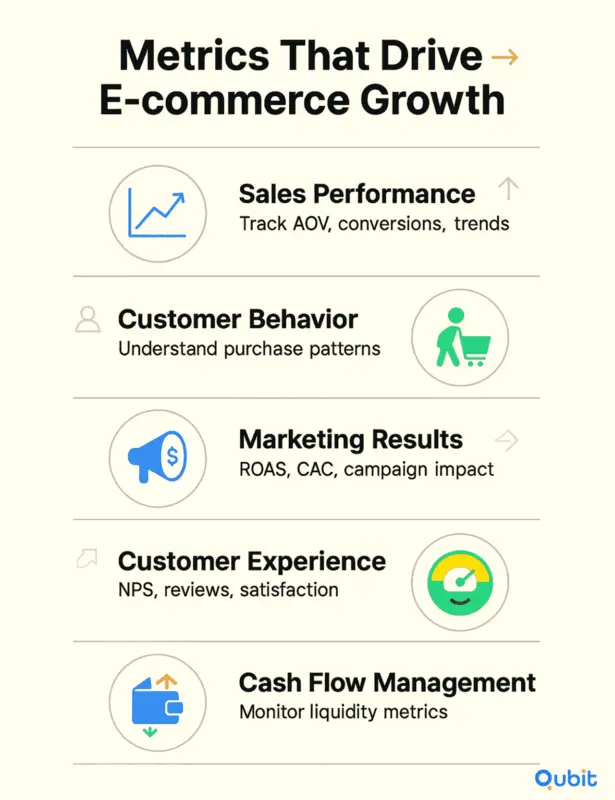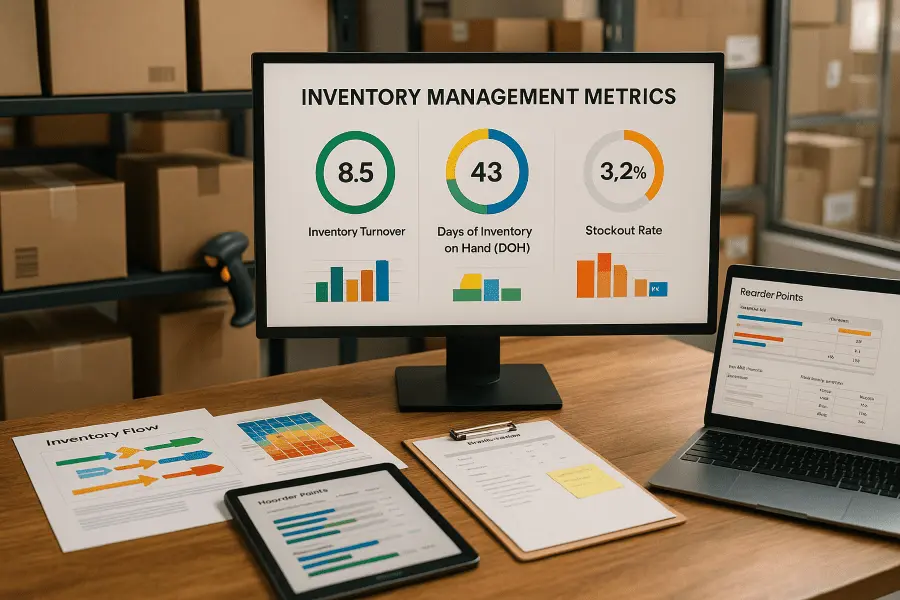The finance function plays a pivotal role in shaping the strategic direction of tech and SaaS businesses. Yet, many organizations struggle to assess its effectiveness. Is your finance team equipped to drive growth, optimize resources, and deliver actionable insights?
For e-commerce businesses, operational efficiency often hinges on inventory management. Surprisingly, 43% of small businesses do not track inventory, highlighting a critical gap in robust metrics. This blog explores the key inventory metrics that drive investor confidence and operational success. From unit economics to growth forecasts, we’ll uncover actionable strategies to refine your approach.
Ready to dive deeper into the metrics that matter? Let’s jump right in!
E-commerce Metrics Investors Expect
Data-driven insights have become the cornerstone of attracting investor confidence in the e-commerce sector. Investors expect businesses to present robust metrics that not only demonstrate operational efficiency but also provide a clear picture of growth potential. Among these, inventory metrics stand out as a critical area of focus.
Inventory data offers more than just numbers—it provides actionable intelligence that helps investors assess the scalability and sustainability of an e-commerce operation. For example, metrics like inventory turnover rates, stock accuracy, and demand forecasting highlight how well a business manages resources and adapts to market trends. These insights instill confidence in investors, showing them that the company is equipped to handle fluctuations and optimize profitability.
The growing importance of inventory management systems underscores this trend. The global e-commerce inventory management system market, valued at USD 3.45 billion in 2024, is projected to reach USD 11.50 billion by 2033. This surge reflects the increasing reliance on data-driven tools to streamline operations and attract investor interest.
Ultimately, presenting well-organized inventory metrics signals to investors that a business is not only operationally sound but also forward-thinking. By showcasing these metrics, e-commerce companies can build trust and secure the financial backing needed for long-term success.
Key Inventory Management Metrics for E-commerce Investors
Let's break down the inventory metrics investors value most, explaining their significance, ideal benchmarks, and practical strategies for improvement.
1. Inventory Turnover Ratio (ITR)
Inventory Turnover Ratio indicates how many times your inventory is sold and replaced within a specific period, typically one year.
Formula: Inventory Turnover Ratio=Cost of Goods Sold (COGS)Average Inventory\text{Inventory Turnover Ratio} = \frac{\text{Cost of Goods Sold (COGS)}}{\text{Average Inventory}}Inventory Turnover Ratio=Average InventoryCost of Goods Sold (COGS)
Why Investors Care:
A higher ITR signals that your e-commerce business effectively manages stock without tying up unnecessary capital. Investors typically look for an ITR of 4 to 8 for e-commerce companies, although this can vary widely depending on your niche.
Example:
Amazon, a leader in e-commerce, has consistently maintained a high inventory turnover ratio, averaging around 8.5 times per year, illustrating remarkable operational efficiency.
How to Optimize:
- Leverage predictive analytics to anticipate demand.
- Reduce slow-moving stock through targeted promotions.
- Negotiate shorter lead times with suppliers to manage just-in-time inventory.
2. Days Inventory Outstanding (DIO)
DIO measures how many days it takes, on average, to sell your inventory.
Formula: DIO=Average InventoryCOGS×365\text{DIO} = \frac{\text{Average Inventory}}{\text{COGS}} \times 365DIO=COGSAverage Inventory×365
Why Investors Care:
A lower DIO indicates that your business effectively converts inventory into cash quickly. Investors favor startups with a DIO lower than their industry's average, typically between 30 to 60 days in fast-paced e-commerce sectors.
Example:
Fashion retailer ASOS reduced its DIO from 120 days down to about 45 days by adopting agile inventory strategies, dramatically improving cash flow and investor confidence.
How to Optimize:
- Regularly reassess your product mix.
- Implement dynamic pricing to accelerate turnover.
- Streamline restocking based on real-time data.
3. Gross Margin Return on Investment (GMROI)
GMROI measures your return for every dollar invested in inventory, emphasizing profitability relative to stock investment.
Formula: GMROI=Gross ProfitAverage Inventory Cost\text{GMROI} = \frac{\text{Gross Profit}}{\text{Average Inventory Cost}}GMROI=Average Inventory CostGross Profit
Why Investors Care:
A healthy GMROI demonstrates efficient inventory investment and profit maximization. Investors typically look for a GMROI greater than 2.5, indicating profitable inventory management.
Example:
E-commerce beauty brand Glossier maintains a high GMROI exceeding 4, driven by lean inventory strategies and high-margin products.
How to Optimize:
- Prioritize high-margin, fast-moving products.
- Reduce markdowns by accurately forecasting demand.
- Focus on supplier negotiations to lower purchasing costs.
4. Stockout Rate
The stockout rate indicates how often your products are unavailable when customers attempt to make a purchase.
Formula: Stockout Rate=Number of stockoutsTotal demand occurrences×100\text{Stockout Rate} = \frac{\text{Number of stockouts}}{\text{Total demand occurrences}} \times 100Stockout Rate=Total demand occurrencesNumber of stockouts×100
Why Investors Care:
High stockout rates negatively impact customer experience and revenue. Industry benchmarks recommend maintaining a stockout rate below 3% to prevent substantial revenue losses.
Example:
In 2022, Shopify reported that businesses experiencing frequent stockouts faced average revenue losses of nearly 12% annually, emphasizing the significance of maintaining adequate stock levels.
How to Optimize:
- Implement automated inventory management software.
- Enhance supplier relationships for quicker replenishment.
- Use predictive analytics to anticipate peak sales periods accurately.
5. Carrying Cost of Inventory
Carrying costs encompass all expenses associated with holding inventory, including storage, insurance, taxes, and obsolescence.
Formula (Annual): Carrying Cost=Total Inventory Holding CostsAverage Inventory Value×100\text{Carrying Cost} = \frac{\text{Total Inventory Holding Costs}}{\text{Average Inventory Value}} \times 100Carrying Cost=Average Inventory ValueTotal Inventory Holding Costs×100
Why Investors Care:
High carrying costs drain profitability and reflect inefficient inventory control. Investors prefer startups maintaining annual carrying costs at or below 20–30% of total inventory value.
Example:
According to the National Retail Federation, carrying costs typically account for 20–30% of the inventory value annually for retail and e-commerce businesses. Effective control strategies can notably reduce these expenses.
How to Optimize:
- Regularly review inventory to reduce obsolete or excess stock.
- Negotiate storage and insurance rates.
- Utilize dropshipping or fulfillment centers to minimize storage costs.
Metrics for E-commerce Businesses
Understanding the right metrics is crucial for e-commerce businesses aiming to thrive in a competitive landscape. Monitoring performance across six key areas—sales performance, customer behavior, marketing results, customer experience, supply chain efficiency, and cash flow management—provides actionable insights to drive growth.

Sales Performance
Sales metrics reveal the health of your revenue streams. Track metrics like average order value (AOV), conversion rates, and total sales to identify trends and opportunities. Comparing month-on-month and year-on-year data adds depth to your analysis, helping you spot seasonal patterns or long-term growth trajectories.
Customer Behavior
Analyzing customer behavior metrics, such as cart abandonment rates and repeat purchase frequency, helps you understand how shoppers interact with your store. These insights can guide strategies to improve retention and optimize the buyer journey.
Marketing Results
Evaluate the effectiveness of your campaigns by monitoring metrics like return on ad spend (ROAS), click-through rates (CTR), and customer acquisition costs (CAC). These figures highlight which marketing channels deliver the best results, enabling smarter budget allocation.
Customer Experience
Customer satisfaction metrics, including Net Promoter Score (NPS) and customer reviews, reflect how well your brand meets expectations. A positive experience fosters loyalty and encourages word-of-mouth referrals.
Supply Chain Efficiency
Efficient inventory management and order fulfillment are critical. Metrics like order accuracy and delivery times ensure your supply chain supports customer satisfaction while minimizing operational costs.
Cash Flow Management
Cash flow metrics, such as operating cash flow and days payable outstanding, ensure your business remains financially stable. Regular monitoring helps you anticipate challenges and maintain liquidity.
Making Metrics Meaningful
Understanding inventory metrics is essential for businesses aiming to attract investor confidence. However, the true value lies in interpreting these metrics in ways that provide actionable insights. By segmenting data effectively, companies can present a clearer picture of their operations and growth potential.
Geographic Segmentation: A Strategic Advantage
Breaking down inventory metrics by geography can reveal trends that might otherwise remain hidden. For instance, comparing regional performance can highlight areas of strength or pinpoint regions requiring strategic adjustments. This approach not only enhances transparency but also demonstrates a company’s ability to adapt to market-specific challenges. Investors are more likely to trust businesses that showcase granular insights into their operations, as this reflects a deeper understanding of market dynamics.
Unit Economics: The Foundation of Business Viability
Unit economics, including contribution margins, offer a comprehensive overview of a business’s financial health. These metrics help quantify the profitability of individual units, whether products or services, and provide clarity on scalability. For investors, this data is invaluable—it illustrates how efficiently resources are being utilized and whether the business model is sustainable in the long term.
By combining geographic segmentation with unit economics, businesses can craft a compelling narrative that resonates with investors. This dual approach ensures that metrics are not just numbers but meaningful indicators of growth and resilience.
Practical Tools for Optimizing Inventory Metrics
Today's technology offers powerful tools for precise inventory management:
- AI-Powered Demand Forecasting: Companies like Blue Yonder claim predictive models can increase forecasting accuracy by 30–40%.
- Real-Time Inventory Management Software: Solutions such as Zoho Inventory and Shopify Inventory provide visibility to improve turnover rates and reduce carrying costs.
- Advanced Analytics Platforms: Tools like Tableau or Looker enable comprehensive data visualization, helping founders clearly communicate metrics to investors.
Conclusion
Achieving operational efficiency requires a strategic approach to inventory management and a clear, data-driven narrative. Throughout this blog, we’ve explored key strategies and metrics that can help businesses optimize their processes and present compelling insights to investors. From understanding inventory turnover rates to implementing advanced forecasting techniques, these methods are essential for maintaining a competitive edge.
A well-structured inventory system not only enhances operational performance but also builds investor confidence. By focusing on measurable outcomes and aligning inventory metrics with business goals, companies can effectively demonstrate their potential for growth and scalability.
We encourage you to apply these strategies to refine your inventory management practices. If you're looking to transform your metrics into investor-ready insights, consider partnering with us. Explore our Investor Discovery and Mapping service to unlock tailored solutions for your business.
Key Takeaways
- Consistent tracking of inventory metrics boosts investor confidence.
- Key areas include sales performance, customer behaviour, marketing effectiveness, supply chain operations, and cash flow management.
- Advanced technologies and AI can significantly reduce forecasting errors.
- A detailed metrics breakdown provides actionable insights for operational improvement.
- Effective segmentation of metrics drives strategic decision-making.
Frequently asked Questions
What are the key inventory metrics for ecommerce?
Sales performance, customer behavior, marketing results, customer experience, supply chain efficiency, and cash flow indicators are essential inventory metrics for ecommerce businesses. These metrics provide investors with valuable insights into operational efficiency and growth potential.


 Back
Back



